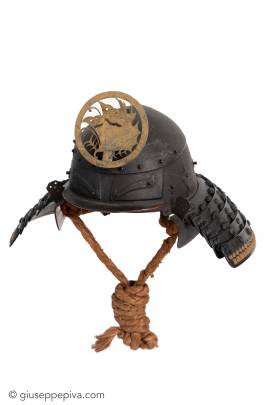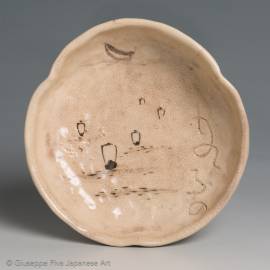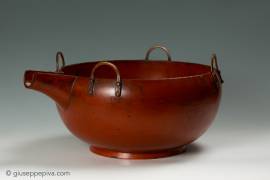Samurai helmet shaped as a head towelSaika, early Edo period, 17th centuryKōshu-Tokubetsu-Kichō-Shiryō certificate The Haruta armourers who moved to Kii province in the early 17th century, took the name from the village where they worked, Saika, near Wakayama, possibly on request of the local daimyō, Asano Yukinaga, a great armour amateur. Specialised in the construction of plate helmets, they produced mainly two typologies of kabuto: one with six plates covered with a chrysanthemum-shaped plate on top and one shaped as a “head towel”, called okitenugui. The latter type...
WORKS FOR SALE
Otagaki Rengestu (1791- 1875)Shallow bowlCeramic; diameter: cm 13.5Signed Rengetsu at the end of the poemTomobako signed by En’nousai (13th Urasenke master)The poem and the picture of this delicate bowl refer to an episode from the Genpei War:Samurai,at the shore of Yashimafloating in the evening tidewhat cannot be swept awaythe crescent moonもののふのやしまのうらの夕しほになかれもあへぬ弓はりの月As recorder in the Heike Monogatari, the army led by the general Minamoto Yoshitsune attacked in 1185 the Heike soldiers camped on the beach of Yashima forcing them to flee on their boats, as illustrated...
Katakuchi yutōA large Negoro lacquered wood hanging ewer for hot waterMomoyama to early Edo period, 16th-17th centuryDiameter: 50.7 cmInscribed on the flat base in black lacquer Todaiji and illegible date Provenance:Todaiji Temple, Nara PrefectureTodoroki Takashi (1938-2016), Tokyo Negoro lacquer wares were produced in Negoro-ji, the head temple of the Shinai Shingon sect of Buddhism. During medieval times, Negoro utensils were used in shrines and temples related to Negoro-ji for everyday use and for ritual purposes. A very important part of enjoying Negoro ware is what...
Copyright © 2016 - giuseppe piva - VAT: 05104180962










